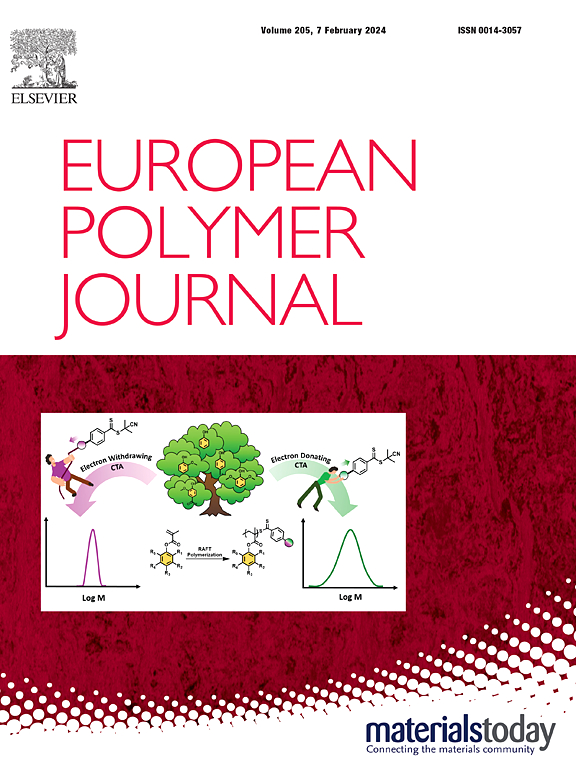β-Cyclodextrin-derived alternating poly(glyco-triazole)s behave as amylose mimics
IF 5.8
2区 化学
Q1 POLYMER SCIENCE
引用次数: 0
Abstract
Carbohydrate-derived polymers combine attractive features like abundant renewable resources, large stereochemical diversity and defined functionalization of the carbohydrates. Starting from β-cyclodextrin, a diazido heptasaccharide was regioselectively obtained in a few steps. It was used as a prepolymer for the A2B2 synthesis of alternating poly(glyco-triazole)s by copper assisted azido alkyne cycloaddition (CuAAC) with two dialkynes of different length and polarity, namely, 1,7-octadiyne and bispropargyl-polyetileneglycol-5. The resulting polymers were completely characterized by FTIR, NMR, MALDI-TOF-MS, SEC MALS, thermal analysis (TG and DSC), and SEM. The alternating insertion of the heptasaccharide and dialkyne in linear polymeric structures was confirmed by NMR and MALDI-TOF experiments. The water-soluble poly(glyco-triazole) containing PEG units had Mn 20,640 and Mw 39,650. The thermal properties (Tg = 27–42 °C) were close to those of amylose but were influenced by the linker. Therefore, these new poly(glyco-triazole)s could be considered as polysaccharide mimics and alternatives to modified native polysaccharides or brush polymers.

求助全文
约1分钟内获得全文
求助全文
来源期刊

European Polymer Journal
化学-高分子科学
CiteScore
9.90
自引率
10.00%
发文量
691
审稿时长
23 days
期刊介绍:
European Polymer Journal is dedicated to publishing work on fundamental and applied polymer chemistry and macromolecular materials. The journal covers all aspects of polymer synthesis, including polymerization mechanisms and chemical functional transformations, with a focus on novel polymers and the relationships between molecular structure and polymer properties. In addition, we welcome submissions on bio-based or renewable polymers, stimuli-responsive systems and polymer bio-hybrids. European Polymer Journal also publishes research on the biomedical application of polymers, including drug delivery and regenerative medicine. The main scope is covered but not limited to the following core research areas:
Polymer synthesis and functionalization
• Novel synthetic routes for polymerization, functional modification, controlled/living polymerization and precision polymers.
Stimuli-responsive polymers
• Including shape memory and self-healing polymers.
Supramolecular polymers and self-assembly
• Molecular recognition and higher order polymer structures.
Renewable and sustainable polymers
• Bio-based, biodegradable and anti-microbial polymers and polymeric bio-nanocomposites.
Polymers at interfaces and surfaces
• Chemistry and engineering of surfaces with biological relevance, including patterning, antifouling polymers and polymers for membrane applications.
Biomedical applications and nanomedicine
• Polymers for regenerative medicine, drug delivery molecular release and gene therapy
The scope of European Polymer Journal no longer includes Polymer Physics.
 求助内容:
求助内容: 应助结果提醒方式:
应助结果提醒方式:


